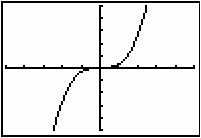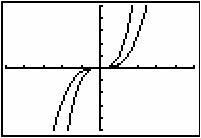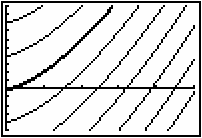This lesson explores the relationship between antiderivatives and indefinite integrals and discusses families of curves. You will also investigate finding antiderivatives graphically and analytically.
Defining Indefinite Integrals
Recall that an antiderivative of a function f is a function F whose derivative is f, that is,
The Fundamental Theorem of Calculus gives another relationship between an antiderivative F and the function f:
where F'(x) = f(x).
If a is a constant, then -F(a) is a constant and we call it C, and the above can be written as
A modified notation,
![]() , is used to represent all the antiderivatives of f. The new notation is called an indefinite integral. So, the indefinite integral is defined as
, is used to represent all the antiderivatives of f. The new notation is called an indefinite integral. So, the indefinite integral is defined as
where F(x) is any one of the antiderivatives of f(x) and C is an arbitrary constant.
|
|||
|
|
|||
Exploring
![]() Graphically
Graphically
Suppose you are to find an antiderivative of f(x) = x2. The Fundamental Theorem of Calculus says that by varying the value of a,
![]() will produce a whole family of antiderivatives, so explore the graph of
will produce a whole family of antiderivatives, so explore the graph of
![]() for a = 0 and see if you can determine an antiderivative of x2. Letting a = 0 will produce one antiderivative of the family of antiderivatives.
for a = 0 and see if you can determine an antiderivative of x2. Letting a = 0 will produce one antiderivative of the family of antiderivatives.
- Enter Y1 = fnInt(T2,T,0,X).
- Graph Y1 in a [-5, 5, 1] x [-5, 5, 1] viewing window.

This antiderivative looks like f(x) = x3. However, graphing Y2 = X^3 together with the antiderivative in Y1 shows they are not quite the same.

The antiderivative in the graph is actually
![]() . Define Y2 as X^3/3 to provide graphical support that
. Define Y2 as X^3/3 to provide graphical support that
![]() is an antiderivative of f(x) = x2.
is an antiderivative of f(x) = x2.
20.1.1 Graph an antiderivative of f(x) = x3 and find an equation for one antiderivative. Support your work graphically.
Click here for the answer.
Checking Indefinite Integrals Analytically
Because
![]() you can check an indefinite integral by taking the derivative of the result. For example, the fact that
you can check an indefinite integral by taking the derivative of the result. For example, the fact that
![]() can be verified by taking the derivative of the result:
can be verified by taking the derivative of the result:
The Power Rule for Indefinite Integrals
The generalized version for antidifferentiation where
![]() is
is
Because the derivative of a constant is 0, the derivative of the result is
Illustrating
![]()
The indefinite integral
![]() may be illustrated by graphing the family of curves that are represented by
may be illustrated by graphing the family of curves that are represented by
![]() for different values of C. For example,
for different values of C. For example,
![]() corresponds to
corresponds to
![]() . Letting C take the values -240, -200, -160, -120, -80, -40, 0, 40, 80, the family of curves is shown below in a [0, 50,10] x [-50, 100,10] window, where the particular curve associated with C = 0 is the darker curve.
. Letting C take the values -240, -200, -160, -120, -80, -40, 0, 40, 80, the family of curves is shown below in a [0, 50,10] x [-50, 100,10] window, where the particular curve associated with C = 0 is the darker curve.

Each curve in the family can be obtained by choosing a different value of C and vertically translating the curve corresponding to C = 0.